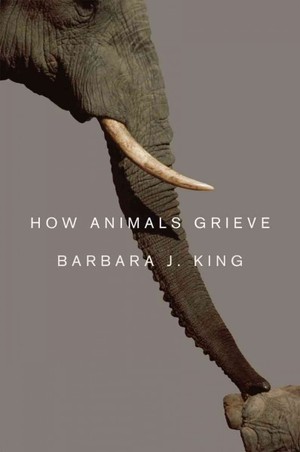Questions For Barbara J. King, Author Of ‘How Animals Grieve’
“There’s a database emerging now in the peer-reviewed scientific literature, ranging from chimpanzees and elephants to dolphins, giraffe, and birds. The next step, I hope, will be to investigate seriously what we ‘animal people’ have known for a long time: that farm animals and our companion animals including cats and dogs may grieve as well.
“In the 19th century, Charles Darwin readily saw emotions as varied as grief, jealousy, and joy expressed by a variety of species. But then there developed a concern that we were projecting our own feelings wrongly onto other animals — in other words, there developed a worry about anthropomorphism. That stance of skepticism has taken a long time to recover from, but in fact we’re once again opening up to a key realization. If we look at their behavior with an open mind, it’s the animals themselves who will tell us in no uncertain terms how deeply they feel their lives.
“Credible definitions, cautious observation, and winnowing out what doesn’t count as grief in the array of animals’ responses to death are all important. But I think the primary requirement is a refusal to assume on principle that human emotions are unique in the animal kingdom.”
It seems, despite the lack of research, like there’s plenty of anecdotal evidence about animal grief — and even biological evidence.

“In the book I tell stories — some gleaned from the scientific literature, others from interviews with animal caretakers — of individual animals and how they expressed love for a relative or friend, then grieved when that other animal died. Rather than writing about grief in the collective or as an abstract, I describe what happened when a gorilla silverback lost his closest gorilla friend, when the house cat Willa lost her sister Carson, when a dolphin mother observed in Greek waters lost her infant. It’s from those stories that patterns, and hypotheses to test, emerge.
“I also describe field scientists who use GPS collars to track elephants’ movements then closely observe the behavior of individuals as they approach the body of a dead matriarch, or others who compare hormonal (e.g., glucocorticoid) changes experienced by monkeys who have lost kin in witnessed predator attacks versus monkeys who have not lost kin but witnessed those same predator attacks. Video, too, is revolutionizing the study of animal emotion; when we film what happens as an animal is dying or dies, we can assess the behaviors by rewatching and coding the tapes, rather than by making snap judgments about what’s unfolding quickly in real time.”
What do you say to skeptics, people who say oh, you’re just anthropomorphizing; there’s no way we can ever tell what an animal is actually thinking?
“Yes, there’s that A word again. I agree that we can’t always, or even often, discern what an animal is thinking. For example, whenever a chimpanzee or gorilla mother is seen carrying the corpse of her baby, the media headlines fly about ‘maternal mourning!’ And that may be right — or it may not. If the mother is going about her normal routine, or simply staring at her baby, we have no firm basis on which to say that she is steeped in grief.
“My definition of grief requires that an animal’s normal behavior routine is significantly altered, and that she shows visible emotional distress through body language, vocalizations, social withdrawal, and/or failure to eat or sleep. So while I do need to follow consistent criteria in describing grief, I don’t need to know what an animal is thinking, any more than I’d need to know what a person is thinking, if he shows marked emotional response to a death.”
You make an interesting distinction — that while all animals are capable of grief, not all of them do grieve. What has to happen for an animal to express what we would perceive as grief?




